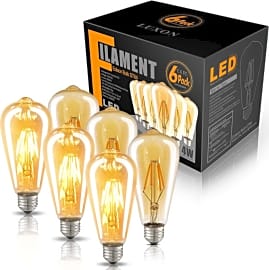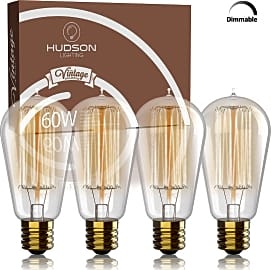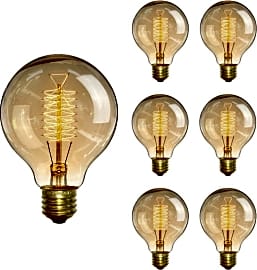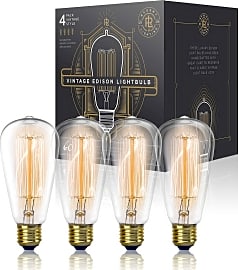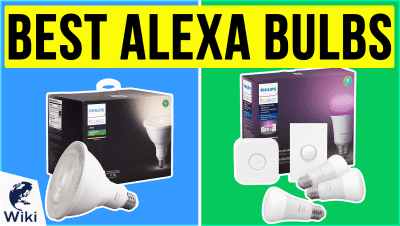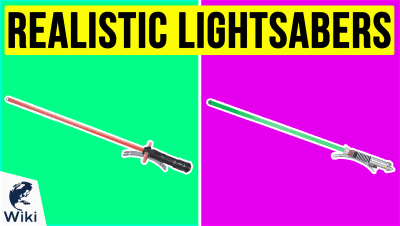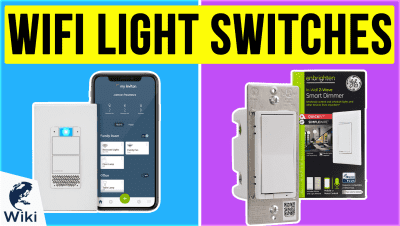The 8 Best Edison Light Bulbs

This wiki has been updated 35 times since it was first published in January of 2017. While Thomas Edison himself couldn't have predicted that his legacy would live on in dark, wood-paneled bars and restaurants catering to hipsters with iPhones, the vintage-style light bulbs bearing his name have made a serious comeback. Now you can make your home feel a little bit more like the 1880s (or present-day Brooklyn) with one of the options that we've ranked for this category. When users buy our independently chosen editorial selections, we may earn commissions to help fund the Wiki.
Editor's Notes
October 11, 2019:
This time around, we eliminated the Luohaoshi T45 – as it no longer appears to be available for order, and added the Yfxrlight Tubular Clear and Luxon Antique Vintage – leaving our top three for this category now composed completely of LED options. While we chose to leave several incandescent options on the lower end of our list, satisfying purists that might insist that nothing less constitutes a true Edison, we felt as if LED selections deserved the podium in this category for the following reasons:
Efficiency: Nobody’s a fan of utility bills, and with 60 and 40 watt equivalents pulling six and four watts respectively, it seems silly to walk away from a tidy 90% reduction in power consumption.
Temperature: Though the heat thrown by traditional incandescent bulbs might be a welcome addition around some of the patios and drafty cafés that these bulbs might decorate, with some users reporting that their Edison bulbs are too hot for certain fixtures or leaving scorch marks on their walls, switching up to cool bulbs and letting the furnace handle the heating situation seems sensible.
Lifespan: With LED options on market rated for 50,000 hours of use, versus around 3,000 hours for comparable incandescent bulbs, this modern technology runs laps around its predecessors, in terms of value.
On top of this, successful troubleshooting seems to have remedied many of the nuisances associated with efficient bulbs in the past (ie: humming, flickering, not dimming and delaying during turn-on), which effectively eliminates most of the negativisms that would’ve worked as a counterpoint. A few things to keep in mind while shopping the category:
Color: Light bulbs use the Kelvin scale to describe the color of the light they emit. Take a moment to consider the space where you’re looking to incorporate these bulbs, and pick a color that’s conducive to your aspirational vibe.
Base: While our rankings are focused on common E26 bases, there are Edison bulbs out there designed to be compatible with a variety of sockets. Do your due diligence prior to purchasing and double check to make sure that the you’re ordering the right bulb for your fixture.
Size: Just because you’re planning to replace a common household bulb with this purchase doesn’t mean that it’ll be the same size. Selecting the right size bulb is a style choice in any circumstance, but under certain conditions a bulb that’s too big might be a deal breaker – if it doesn’t fit into your intended fixture. Make sure that the dimensions of the bulb you’re ordering will be conducive to the fixture you’re refitting.
What’s Old Is New Again
That being said, it’s also a huge energy-waster and much less efficient than its counterparts.
Anyone who’s seen a mason jar chandelier or observed a corduroy-clad man sporting a handlebar mustache knock back an old fashioned can tell you that nostalgia for the 19th century is an undeniable trend among millennial-aged adults. It has crept into home and restaurant decor and influenced everything from clothing to food, so it’s no surprise that retro lighting has made its way into every fashionable bar on the block. If you’re eyeing this list, you’re likely on the cusp of obtaining a few old-school bulbs yourself. But just what are you buying?
First and foremost, the Edison bulbs on the market are reproductions that contain a tungsten or LED filament. Both types are capable of producing a flattering golden glow and can fit in standard-sized sockets. Many are compatible with dimmer switches, and some can even integrate with smart lighting systems.
As far as the filament type goes, there is a big difference between tungsten wire and LEDs. Tungsten is a metal that has been used for over 100 years, so it’s ideal if you’re shooting for a genuine vintage theme. That being said, it’s also a huge energy-waster and much less efficient than its counterparts. You should expect to replace bulbs that use tungsten often, especially if you have them on for more than three hours a day. LEDs mimic an antique appearance admirably and manage to emit double the lumens as tungsten bulbs, plus they last about six times as long.
In keeping with their vintage style, a handful of selections sport brass screw bases and offer glass bulbs in all shapes and sizes. Popular formations include overlarge globes, tapered candles, tubular, and pear-styles. You'll also want to choose a filament configuration that best suits your personal tastes. There are elaborate helixes, artistic squirrel cages, and industrial-looking hairpin loop designs, to name a few.
How Incandescent Light Bulbs Work
Incandescent lamps were one of the first types of electric light ever invented. Impressively, they’re still used to this day, even among the myriad other lighting methods available. The way they work has remained relatively unchanged since their inception in the 1800s.
Although the future looks dim for the incandescent bulb, there are still opportunities for manufacturers to innovate greener versions.
They operate by way of incandescence, which is the emission of photons produced by heat. Typically, they consist of a glass enclosure surrounding a wire filament. Initially, filaments were made of carbon or platinum, although neither panned out very well. It didn't take long for inventors to discover that tungsten worked swimmingly, so much so that it's still the metal of choice today. Bulbs usually contain an inert gas that prevents the filament from breaking down due to oxidation.
At the base, there are two metal contacts attached to an electrical circuit. When a bulb is connected to a power source, electricity runs from one contact, through the filament, and down to the other. When this happens, the electrons in the current make contact with the filament's atoms and force them to vibrate. Eventually, this creates enough energy to heat the atoms to temperatures high enough to emit visible light.
The problem with this process is that over 90 percent of the energy a light bulb uses takes the form of non-visible heat, which is why in recent years they've been decried as wasteful and environmentally unfriendly. Governments around the world began to phase out the manufacture and sale of incandescent lights that don't meet efficiency standards in the early 2000s.
Since Edison bulbs fall under the specialty lighting category, they, along with many others, are exempt from the restrictions set forth in the United States.
Although the future looks dim for the incandescent bulb, there are still opportunities for manufacturers to innovate greener versions. Their romantic familiarity and the flattering light they release makes them an ideal candidate for reinvention.
The Birth Of The Bulb
Like most revolutionary inventions, the light bulb was the result of the combined efforts of a slew of inventors. While Thomas Edison has certainly cemented himself in history as the brain behind the bulb, he did not actually invent it on his own. That being said, he still went to great lengths to improve it. The developments he and his army of scientists made enabled him to sell his product to the masses, which is part of what helped to link him with light bulbs forever.
Around the same time, Edison had been researching how to develop incandescent lighting technology further.
Throughout the 19th century, numerous breakthroughs were made in electric lighting. One of the most well known came from British chemist Joseph Swan. In 1878, he debuted a lamp that used a slender carbon rod filament. It required too much energy to be practical, but laid the groundwork for a more streamlined design that used carbonized paper. Enthusiasts installed his new light bulb in various homes and landmarks throughout England.
Around the same time, Edison had been researching how to develop incandescent lighting technology further. He recognized that a thin filament made from a substance with high electrical resistance would make a lamp last longer and require less current. In his quest to find something suitable, he and his associates experimented with thousands of plant materials, from hickory and cedar to flax and fishing line. When they finally came around to bamboo, they had struck gold. A carbonized bamboo filament can successfully last 1,200 hours, which was leaps and bounds beyond carbon. In 1880, the Edison Electric Light Company began marketing this revolutionary new product.
In December of 1904, two inventors named Sandor Just and Franjo Hanaman received a Hungarian patent for a tungsten rod lamp, which lasted longer and burned brighter. Soon after, William D. Coolidge came up with a way to make ductile tungsten, which could be formed into thin wires. In 1913, Irving Langmuir discovered that filling a bulb with an inert gas instead of a vacuum doubled luminous efficacy and helped diminish blackening.
The improvements kept on coming. These days we have everything from smart lights to realistic lightsabers, and it’s all thanks, in part, to the discovery and application of incandescence.


